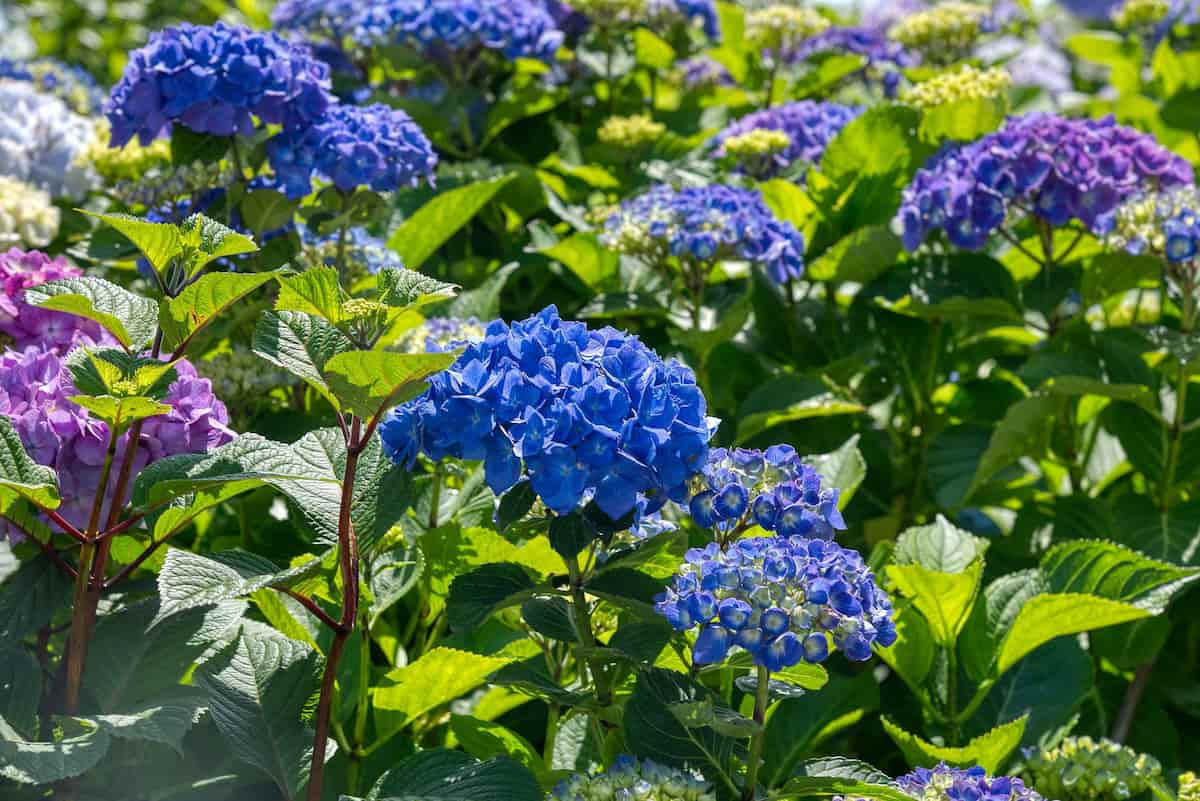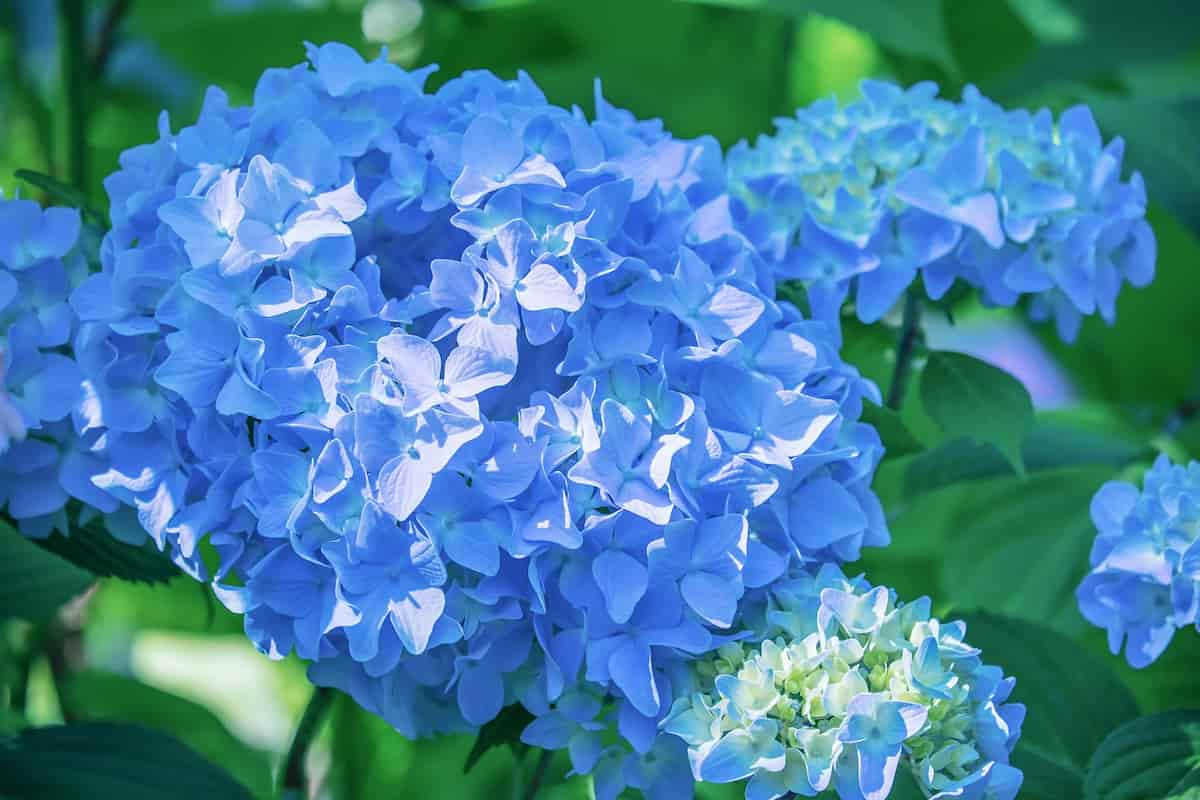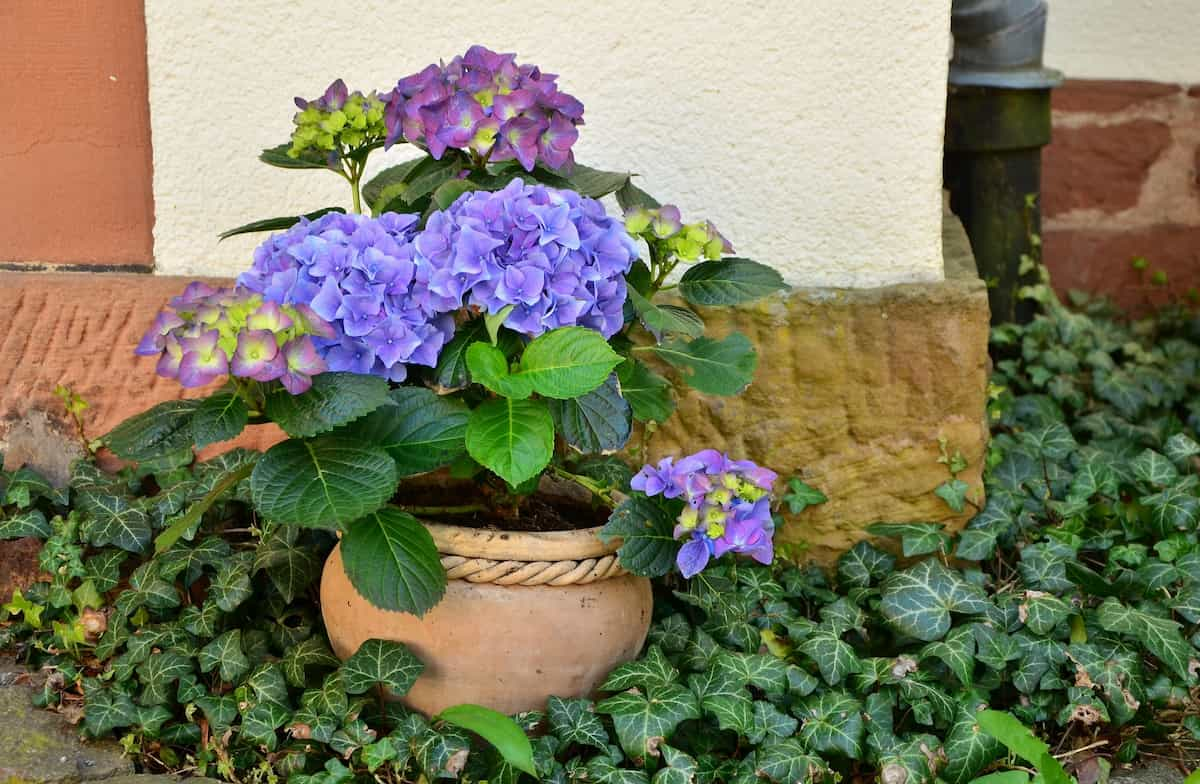Hydrangeas are one of the most popular flowering plants in the world. They’re easy to grow, require little care, and are perfect for shady areas ornaments. These blooms come in various colors and shapes. Hydrangeas are the most popular perennials in gardens. They are easy to grow and maintain but require proper care to stay healthy. These flowering plants typically have blue, pink, or white petals and can grow up to six feet tall. Hydrangeas are also known for their large, lush leaves and fragrant flowers.

How to grow and care for hydrangeas
Hydrangeas varieties
There are many different types of Hydrangeas, each with its unique characteristics. Some Hydrangeas are known for their large, dome-shaped heads of flowers, while others are more compact in shape and produce smaller flowers. Some Hydrangeas are drought tolerant, while others need regular watering. Some have sweet-smelling flowers, while others have a more medicinal odor.
- Bigleaf Hydrangeas – There are many Hydrangeas, but some of the most popular include the bigleaf Hydrangea, a large shrub or small tree that typically grows to around 6-8 feet tall.
- Panicle Hydrangeas – There are many, but the most popular is panicle Hydrangeas. These plants have long, narrow leaves that droop down along the stem. They grow best in areas with a lot of moisture and can be found in nurseries and garden centers across the country.
- Oakleaf Hydrangeas – There are many different types of Hydrangeas, but the oakleaf Hydrangea is perhaps the most well-known. This type of Hydrangea has large, oval leaves that are often dark green. The flowers on these plants are typically pink or purple and have long petals.
In case you missed it: How to Grow and Care for Chinese Evergreen Indoors: Tips and Ideas for Beginners

Climate suitable for growing Hydrangeas
Hydrangeas are perennials that grow best in acidic, neutral soils with adequate moisture. Hydrangeas should be grown in a location with a cool, moist spring and fall and a warm, dry summer and winter. Although Hydrangeas are hardy in most areas, they may require protection from frost if grown in colder climates. Hydrangea bushes need a minimum soil temperature of 14°C during the day and 10°C at night.
These temperatures are necessary to encourage leaf growth and blooming on your Hydrangeas. Some people like to plant their Hydrangeas in the fall or winter when the temperatures are cooler. Others plant them during the warmer months. The perfect time to plant your bulbs is after all the frosts have subsided but before the ground begins to harden. When planting, ensure that the rootball is completely covered with soil and that there are no gaps between the bulb and the surrounding earth.
Water requirement for growing Hydrangeas
The water requirement for growing Hydrangeas is approximately 2.5 gallons per foot of height, but this amount can vary depending on the variety and how much misting is done. Most Hydrangeas need at least an inch of water per week, though some may require up to two inches.
Keep the soil moist, and water the plants once a week during the summer and once a month during the winter. Hydrangeas can be watered using a watering can or wet sponges to soak up water from below the plant. When watering Hydrangeas, use warm water rather than cold water, which can shock the plant.
In case you missed it: How to Grow and Care for Ocotillo in Pots: A Beginners Guide

Soil requirement for growing Hydrangeas
Most Hydrangeas prefer well-drained soil with plenty of organic matter for healthy growth. You will also want to add some fertilizer to the soil before planting your Hydrangea bulbs. The amount of soil required will vary depending on the climate and type of Hydrangea being grown. In general, however, well-drained soil is necessary for Hydrangeas. If you get significant rainfall, add organic matter (fertilize with compost or manure if available) to your Hydrangea’s soil mix.
This will help minimize the chances of your plants succumbing to root rot or other diseases. Be sure to water your plants thoroughly after adding any organic matter. If you don’t receive a lot of rainfall, you’ll need to amend the soil with sand or crushed rock instead of organic matter. Make sure the pH level of your Hydrangea’s soil is between 6 and 7 before planting.
Propagating Hydrangeas
From cuttings
Propagating Hydrangeas from cuttings can be a fun and easy way to grow new plants. Cut off healthy stems from your Hydrangea plants, removing any brown or diseased tissue. Make a slant cut about 1 inch below the stem where the stem begins to branch out. Make another similar cut on the opposite side of the stem. Remove all leaves and flowers from these cuts. Dip the ends of the cut stems in rooting hormone powder and insert them into the soil mix two at a time. After planting, water it well and keep it moist until new growth appears.
Rooting branches directly in the soil
To propagate Hydrangeas by rooting branches directly in the soil, begin by removing any old root systems from the branches. Gently tease out any old roots with your fingers, then make a small hole in the soil near the base of the branch and insert it. Water well and keep an eye on the plant to ensure it gets enough water. If new growth begins at the branch’s base, you can remove the root and plant the branch in fresh soil.
In case you missed it: How to Grow and Care for Bloodroot Plant: A Beginners Guide

Hydrangea plant care
Hydrangea plant care in winter
Hydrangeas are the most popular garden plants and are a great winter addition to any yard. Start preparations early. Remove any dead or diseased foliage in the spring, and begin preparing the soil in late summer or early autumn. Amend the soil with organic matter and lime if necessary. Protect Hydrangeas from harsh weather conditions. Cover them with tarps or plastic sheets during inclement weather, and water them sparingly when temperatures drop below freezing.
Provide moderate amounts of light throughout the winter. Place Hydrangeas near a sunny window or inside a well-lit greenhouse if possible. If you can’t place them near direct sunlight, supplement their light with artificial sources such as grow lights or compact fluorescent bulbs. Feed your Hydrangeas sparingly during the winter months. Use a low-nitrogen fertilizer specifically designed for houseplants instead of regular garden fertilizer.
Fertilizer requirement for growing Hydrangeas
Hydrangeas are among the most popular shrubs in the garden, and for a good reason. Once established, they provide attractive flowers in various colors for many months each year. One downside to growing Hydrangeas is that they can be susceptible to problems such as fungal infections and insect damage. To help minimize these problems, fertilize Hydrangeas during the early spring when growth is fastest.
Overfeeding can cause foliage distortion, yellowing of leaves, and even death of plants. Use only enough fertilizer to achieve desired results; too much can lead to excess salts in the soil, damaging roots and plants. Keep Hydrangea bushes well-weeded throughout their growing season to avoid the accumulation of mineral deposits on the soil’s surface, which can inhibit root growth and promote fungal growth.
In case you missed it: How to Grow and Care for Bleeding Heart Plant: A Beginners Guide

Pruning Hydrangeas
Hydrangeas are popular flowering shrubs that can be grown in various climates. They require little maintenance and can grow to impressive sizes. There are several ways to prune a Hydrangea, but the most common is to clip the top off the plant in early winter when the new growth has stopped and the old growth is starting to die back. This will keep the Hydrangea in shape and prevent it from becoming too dense or leggy.
When it comes to Hydrangeas, there are a few things you need to keep in mind if you want them to look their best. Pruning is one of the most important aspects of keeping these plants healthy and looking their best. Prune your Hydrangeas in the spring, when new growth begins. Make cuts at an angle around the stem, about 1 inch above the ground. This will encourage new shoots to grow and strengthen the plant. Avoid cutting off too much foliage; leave about 1/2 inch on each stem.
In case you missed it: How to Grow and Care for Cyclamen Indoors: A Beginners Guide

Pests and diseases of Hydrangeas and their control
Many pests can affect Hydrangeas. The most common are aphids, scale insects, and whiteflies. Aphids suck the sap from the plants, causing them to curl and die. Scale insects cause leaves to turn yellow and fall off. Whiteflies lay eggs on the plants, and when the larvae hatch, they feed on the sap, causing leaves to droop and turn brown. There are several ways to control these pests. Follow the label directions carefully. Trap and remove aphids using a black light trap or sticky boards with sweet oil applied to their surface. Aphids aren’t attracted to light, so they stay trapped on the board until you dispose of it properly.
Remove scale insects using a vacuum cleaner with the hose attachment set to low suction. Cover all leaf surfaces and do not damage buds or flowers. Remove all debris before vacuuming, so you don’t spread any pathogens around your garden. Plant-resistant varieties, if possible. Some Hydrangea cultivars are naturally resistant to some pests, while others may require treatment with a systemic insecticide or miticide before they become infested.
Hydrangeas are popular landscape plants that can be grown indoors or outdoors in various climates. Several diseases can affect Hydrangeas, but most can be controlled with regular watering and pruning. One common disease is powdery mildew, which is caused by a fungus. Symptoms include patches of fluffy white growth on the leaves, and the leaves may turn yellow or brown. Treatment involves spraying the plant with a fungicide.
Other diseases affecting Hydrangeas include verticillium wilt, stem rot, and aphids. Stem rot is caused by a fungus, while verticillium wilt is a viral infection. Aphids feed on the plant’s sap, and their feeding can cause leaf spots or stunted growth. Control measures for these diseases include spraying the plant with an insecticide, removing aphids and other pests with a vacuum cleaner, and watering regularly to keep the soil moist.
Conclusion
Hydrangeas are the most popular plants in the world and for a good reason. Their delicate blooms and lush foliage make perfect additions to any garden. But growing Hydrangeas can be challenging, especially if you want them to thrive in a temperate climate. If you want to grow Hydrangeas, ensure your garden soil is well-drained.
Hydrangeas need plenty of oxygen and water to grow well. Second, fertilize them regularly with balanced nitrogen and potassium fertilizer. Finally, keep an eye on the Hydrangea’s water needs – they can get thirsty quickly. This article provides some tips for growing Hydrangeas successfully in a home garden. From choosing the right location to planting techniques, learn everything you need to know to grow these beautiful flowers.
- Where to Place Indoor Plants in Your Home
- How to Grow Tomatoes Organically at Home: A Comprehensive Guide
- Organic Gardening on a Budget: Low-Cost Methods and Materials
- Gongura Seed Germination and Planting Methods
- Cabbage Seed Germination and Selection
- Broccoli Seed Germination and Selection
- Asparagus Seed Germination and Variety Selection
- Seasonal Flower Gardening: Best Practices for Spring, Summer, Fall, and Winter
- How to Grow Hibiscus from Flower
- Plantation Ideas for Home Decoration: A Beginners Guide
- Flower Garden Designs and Layouts for Beginners
- Planting and Spacing Techniques in Papaya: A Beginner’s Guide
- Growing Gold: Essential Techniques for Planting Pineapples
- How to Make Kalanchoe Plant Bushy: Home Remedies and Solutions
- 11 Reasons Why Your Gardenia is Not Blooming: Home Remedies and Solutions
- Eco Elegance: The Guide to Designing a Drought-Tolerant Landscape
- Gardening on a Slope: Strategies for Hillside Landscaping
- Nourish and Flourish: Top Organic Mulches for Thriving House Plants
- Everything You Want to Know about Indian Mogra Flower: Discover Uses and Growing
- Green Thumb Success: Expert Tips for Cultivating Greenhouse Pumpkins All Year Round
- Maximize Growth & Flavor: The Ultimate Guide to Companion Planting in Herb Gardens
- How to Control Rhododendron Problems Naturally: Home Remedies and Organic Ways to Fix Them
- Natural Magic: The Remarkable Benefits of Cinnamon for Plants
- Best Steps to Revive Dying Tulip with Natural and Organic Treatment
- 10 Reasons Why Your Angel Trumpet is Not Blooming: Remedies and Treatment
- How to Fix Periwinkle Leaf and Flower-Related Problems: Natural Remedies and Solutions
- How to Fix Zinnias Leaf and Flower Problems: Discover Natural and Home Remedies
- Organic Steps to Induce Lemon Tree Flowers: A Comprehensive Guide
- Bloom Booster: Crafting the Perfect Homemade Bougainvillea Fertilizer
- Optimizing Growth: A Guide to Applying NPK Fertilizer for Potted Plants
- 10 Best Homemade Fertilizers for Rubber Plant: DIY Recipes and Application Method
- How to Boost Female Pumpkin Flowers: Effective Steps for More Flowers and High Yields
- Transform Your Indoor Garden: Top Benefits of Pink Salt for Houseplants
- 10 Best Homemade Fertilizers for Peacock Plants (Calathea): Easy DIY Guide
- Unlock Blooms: 9 Reasons Why Your Potted Chrysanthemum is Not Blooming
- 8 Reasons Why Your Potted Hibiscus is Not Blooming: Fix it with Simple Solutions